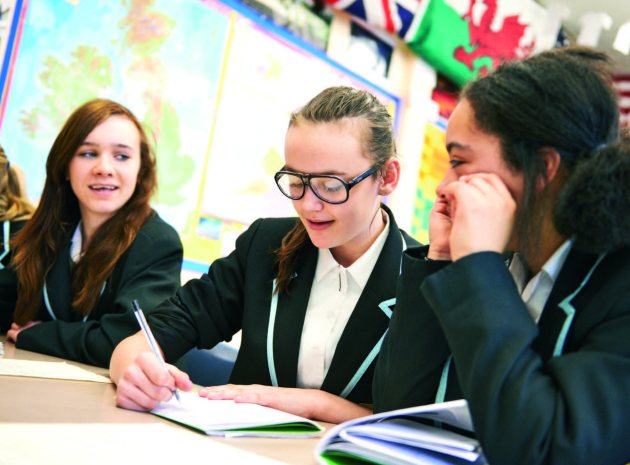Students become part of Charles Booth’s team of researchers in Lisa Pool’s lively and interactive introduction to the 1906-1911 Liberal Reforms…
Today you will…
GAIN AN UNDERSTANDING OF THE STANDARDS OF LIVING OF POOR FAMILIES IN LONDON ACTIVELY CONTRIBUTE TO THE RESEARCH PROCESS OF CHARLES BOOTH’S TEAM TODAY YOU MIGHT… APPRECIATE THE EXTENT OF POVERTY AND THE EFFECT ON FAMILY LIFE, NUTRITION AND WELFARE CONSIDER LINKS BETWEEN STUDIES INTO POVERTY & THE LIBERAL REFORMS.
In this lesson, pupils are gaining an introduction to the Liberal Reforms of 1906-1911 by examining the studies into poverty that contributed to these political milestones. Whilst the various acts of the Liberal Government are the key topic area of the exam syllabus (Edexcel GCSE History A), this session provides pupils with two additional learning opportunities: first, to gain an insight into the research behind Booth’s ‘Wealth & Poverty Map of 1901’, and secondly, to develop an understanding of the effort involved in putting such research together. Therefore, this lesson suggestion is largely based on popular, but trickier to control, role-playing, requiring pupils to assume the persona of either a researcher or a London family demonstrating levels of poverty experienced in the capital at the turn of the twentieth century. A previous lesson would have shown documentary clips (I used Andrew Marr’s ‘Making of Modern Britain’) to plant the seed of a phenomenal social divide between rich and poor and that understanding the reforms is based considerably in an understanding of the acute poverty of city dwellers. So hopefully, a significant contextual study can, with some choice sound effects and careful planning, be a memorable lesson!
STARTER ACTIVITY
SETTING THE SCENE
Some help in setting the scene is needed, as Victorian poverty is very abstract to pupils; time for a cuppa! Pupils should be greeted at the door with a cup of tea, preferably hideously stewed or so weak it looks like the Thames at high tide. Disposable cups should be only half-filled and a central point allocated for leaving them. To accompany the revolting tea should be a slice of bread. Therefore, physically, pupils have an idea that austerity and hardship is inherent to the lesson.
On the board should be a section of the Wealth & Poverty Map to pique curiosity. If possible, use a section that has a familiar street or landmark for pupils. Once learners have deposited bags, books and ‘their dinner’, they will see the room is organised into four bases: one acts as Research Headquarters, the other three (as spread out as space allows) serve to provide ‘homes’ for each London family. An unorthodox start of tea and bread can cause the gigglyometer to rise rapidly, so it is important to set up the room beforehand, with chairs and writing space accessible. Once pupils are seated, steady the atmosphere by turning off lights and showing a montage of archive photos of poorer districts of London showing clothing, street scenes, interiors of housing and some individuals and families. Forethought to pairings or groups is probably a good idea but it can also work well to let the groups naturally sort, with some conditions as to ‘no more than three per family’. Once the montage has been shown, keep lights off and ask pupils for one memorable aspect of the images each. Instructions are then given out: the Researchers have to gather information on a neighbourhood of London and will be making house-to-house enquiries. Families (with varying attitudes!) will answer their doors and provide information to the researchers. In the second part of the lesson, all pupils will be working on producing a summary. Use a high-impact sound effect to signal the start of the interviewing: Big Ben, a whistle or a drum-roll perhaps.
MAIN ACTIVITIES
Once instructions are given out, pupils should open their envelopes that are placed at their bases. These should not be personalised and will include (for researchers) some suggested questions and space for alternatives and follow-ups, and profiles (for family members) outlining key social and economic details on family income, average meals, numbers resident in household, level of skill and nature of employment, age, children, health issues etc, gathered from Census records and sources. The headings should be standardised, to allow the question-setters some uniformity, but the details different for each family. It is important to give the pupils time to absorb their character details: the next five minutes should enable pupils acting as family members to read profiles and consider a) possible questions they may be asked and b) what their attitude is to their visitors-an allocated space on worksheets can be included. Researchers should consider their questions, amending them and adding follow-up questions in the space provided. Make it clear that every pupil could be scored for behaviour, politeness and clarity. Once the background has been absorbed, the mayhem begins. On a clear ‘start noise’ the researchers split up and visit all ‘families’, recording the information in note form. There will need to be a maximum time for each visit, since friends are likely to want to spend longer ‘researching’ their friends’ homes, so a suggested four-six minutes should be the pre-arranged time per house call. There is obviously a more passive role potential here: the researchers are gathering and recording information, thereby gleaning more new material than their peers acting as families. It is also important to realise that the researchers’ questions should all be different, to prevent repetition (and inevitable boredom) by the families. This section is obviously the most rowdy but should have the tone of a controlled ‘information hunt’ involving all pupils.
Although noisy and perhaps uncomfortable, let the pupils engage with each other beyond the interviewing of the researcher. However, at a pre-determined time, the pupils must stop their activities, sit down and rate any three of their peers out of ten in terms of politeness, clarity and behaviour: this allows pupils (and you) that magic two minutes to settle and re-group: this scoring should be done on the pupils’ paperwork.
In the final activity, pupils need to change roles and all become members of Booth’s Clipboard Army (have a picture of Booth on display to add gravitas). In the following activity, pupils are to consolidate the work of the previous task and compile a report on the findings of the research via a writing frame. Here the projector should go back to the original Booth Map, zoom in to a specific street where a ‘typical street’ photo can be seen. This then gives the pupils the notion that their report has a concrete historical basis.
Summary
This absolutely should expect the pupils to feed back on the interviewing task.
Questions can include:
- What were the problems experienced by the researchers (lack of cooperation, time etc)?
- What factors did the families have in common (irregular work, overcrowding etc)?
- Which part was the most memorable (allow for some daft off-record moments!)?
- What does the research tell us about parts of London?
- What impact do you think this had on politicians?
TAKE IT FURTHER
This lesson clearly is a starting point. Subsequent sessions should, in turn, consider the scale and findings of Booth’s research and their impact on the efficiency of Britain’s workforce, military recruitment and social attitudes towards poverty. It is critical that the next lesson begins with pupils’ written reports and can filter into an exam-style question, a newspaper activity or a storyboard based on six to eight pictures used in the montage. A specific homework to follow this lesson is a letter to the Prime Minister (Marquess of Salisbury or Arthur Balfour), outlining the situation in inner cities and suggesting improvements or reasons for concern.
Info bar + DIFFERENTIATION
YOU MAY WANT TO NOMINATE MORE ABLE STUDENTS AS RESEARCHERS, AS THERE IS MORE SCOPE HERE FOR FREE-STYLING QUESTIONS. LESS ABLE STUDENTS COULD READ FROM THEIR PROFILES (AS FAMILY MEMBERS) OR ACT AS INTERVIEWERS, BUT WITH AN ASSISTANT TO RECORD ANSWERS. ASKING THEM TO SUMMARISE THEIR FAMILY’S PREDICAMENT TO THE TEACHER WILL MAKE THE INTERVIEWING AND UNDERSTANDING OF PROFILES MORE ACCESSIBLE.
KEY RESOURCE
CHECK OUT SECONDARY STARTERS AND PLENARIES: HISTORY – A BRAND NEW RESOURCE FOR BUSY HISTORY TEACHERS WITH 50 READY-TO-USE, CREATIVE IDEAS. TRIED AND TESTED ACTIVITIES COVER THE WHOLE SPECTRUM OF ESSENTIAL TOPICS. INDIVIDUAL AND WHOLE-CLASS RESOURCES TO ENGAGE STUDENTS ARE INCLUDED, WITH POWERPOINTS, TASK SHEETS AND OTHER TIME-SAVING RESOURCES AVAILABLE ONLINE. BLOOMSBURY EDUCATION PROVIDES PROFESSIONAL DEVELOPMENT RESOURCES, TEXTBOOKS AND GUIDES TO INSPIRE NEW AND EXPERIENCED TEACHERS ALIKE – EXPERT AUTHORS INCLUDE TOM BENNETT, PHIL BEADLE AND SUE COWLEY. (BLOOMSBURY.COM/EDUCATION, ACBEDUCATION@BLOOMSBURY.COM, OR CALL 01256 302688)
About the Expert
Lisa Pool is a history teacher at Chilton Cantelo School (chiltoncanteloschool.co .uk), which is part of Cognita Schools, the UK’s leading group of independent schools (cognitaschools.co.uk).









